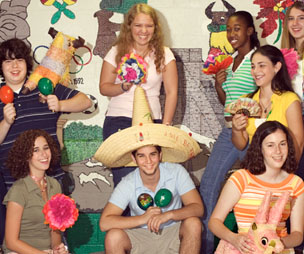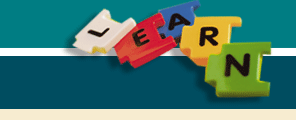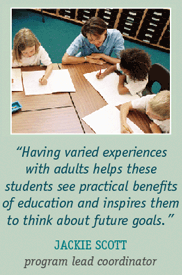 |
|
 |
 |
|
||||
 |
Afterschool Programs in Rural Areas: A Conversation With Claudette Morton “I’d rather live on the side of a mountain than wander through canyons of concrete and steel,” sang John Denver in 1973. Years later, many families share Denver’s preference for country life over city living. In 2003, some 25% of public school students lived in communities of 25,000 or less, or what we would consider rural areas.1 To learn more about afterschool programs in rural areas, we talked to Claudette Morton, a member of the National Partnership for Quality Afterschool Learning’s steering committee. Morton was recently recognized as one of Edutopia magazine’s “daring dozen” for her efforts to improve education in rural areas. Her experience with afterschool began early in her career with a job at an afterschool program with the Parks and Recreation program in Billings, Montana. Today, Morton is the executive director of the Montana Small Schools Alliance. Morton encourages rural afterschool programs to play to their strengths to meet the unique challenges they face, such as geographic isolation. One of the advantages of living in a small town is that you really do know everyone. While you might not be able to go to Home Depot or other national chains for partnerships or donations, you can talk to the owners of the local stockyard or grain elevator. Chances are they know you—and your students—and will be happy to help out. Many rural afterschool programs are also able to tap into existing programs for resources. This includes paying certified teachers to work an additional few hours in afterschool and partnering with organizations like 4-H, a youth organization that includes agriculture education and activities in its programming. Indeed, two of the most important strategies that Morton suggests are ones that high-performing afterschool programs, both rural and urban, use: working with the regular day school and developing strong community ties. 1National Center for Education Statistics. (2003.) Table 6: Number of public school students, by locale code (CCD) and state (fall 2003). Retrieved June 15, 2007, from http://nces.ed.gov/surveys/RuralEd/TablesHTML/6localestudents.asp |
|

|
|||||||||||||||
|
Questions or comments should be directed to: Laura Shankland |
Copyright © 2007 by SEDL . This newsletter was produced in whole or in part with funds from the U.S. Department of Education under contract number ED-01-CO-0057/0001. You are welcome to reproduce issues of AfterWords and distribute copies at no cost to recipients. Please credit SEDL as publisher. Link to PDF versions of AfterWords is available here. For additional uses, please fill out and submit a copyright request form. |






